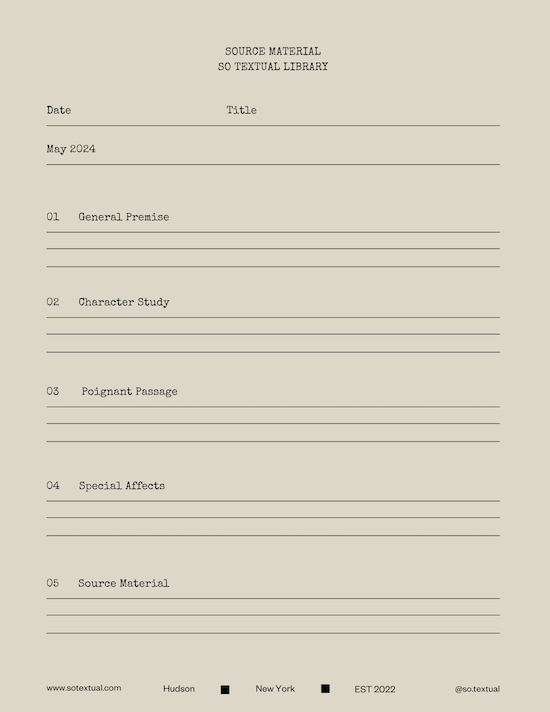PLAY IT AS IT LAYS
The Book Club Archive
The Book Club Archive
There is a stillness to Play It as It Lays that feels like the heavy silence before a heatwave. As we sat with Joan Didion’s sparse, cutting prose, the discussion lingered in the spaces between her sentences—the silences she carves into the narrative like sun-bleached paths through the Mojave. Maria Wyeth, Didion’s protagonist, moves through the hollow landscapes of Hollywood, Nevada highways, and psychiatric institutions with a detachment that is both chilling and deeply resonant. The novel confronts us with questions that are hard to ask aloud: What happens when meaning slips away? What does survival look like when all you have is motion?
We began with Maria herself, a character who seems defined by her refusal to participate. Didion presents her not as a heroine but as an anti-figure—neither victim nor victor, just a woman circling the void of her life. Once a promising actress, Maria now exists on the fringes of her former world, playing out the empty rituals of her existence: driving endlessly through Los Angeles, gambling in the desert, enduring her estranged husband’s indifference, and carrying the quiet burden of grief after her abortion. Maria’s detachment became a central point of our discussion—was she apathetic, or was she simply doing what was necessary to survive? Didion, with her surgical precision, offers no answers. The story unfolds like a mirage, and Maria remains an enigma.
WHAT WE DISCUSSED
The group reflected on Didion’s portrayal of California, a state that glitters with possibility but feels empty at its core. Los Angeles, in particular, loomed large in our conversation as a city that promises reinvention but delivers isolation. Didion’s Hollywood is not glamorous; it is suffocating, a machine that churns through people like Maria and spits them out. The landscape itself feels complicit in her unraveling: the cracked highways, the endless desert, the sterile white light of day. We talked about how Didion writes place not just as a backdrop but as a living, breathing character, one that shapes and erodes the people who inhabit it.
Maria’s relationships—or lack thereof—also drew considerable discussion. Her estranged husband, Carter, is cold and transactional, a man more concerned with his career than the wreckage of their marriage. Her friends, if you can call them that, orbit her life but never quite touch her. Even her connection to her daughter, Kate, feels distant, filtered through institutional glass. And yet, Maria’s love for Kate seemed to be her only tether to meaning—a fragile thread she clings to in a world that has otherwise dissolved into chaos. One member described this as Didion’s cruel brilliance: the way she captures how love, even in its faintest form, can sustain a person just enough to keep them moving.
We lingered on the abortion scene, a passage so stark and unadorned that it left many of us breathless. Didion’s refusal to moralize or sentimentalize this moment felt revolutionary. It is not an event but a fact, a part of Maria’s existence as undeniable as the desert heat. The group marveled at Didion’s ability to distill profound emotional weight into a single, unembellished scene. It sparked a larger conversation about the novel’s tone—how Didion strips everything to its essence, leaving only the bone-dry truth.
CRITICAL COMMENTARY
We couldn’t discuss Play It as It Lays without addressing Didion’s voice, that distinctive, razor-sharp style that has become her hallmark. The novel’s fragmented structure mirrors Maria’s fractured psyche, and the sparse prose feels almost clinical in its detachment. Yet, beneath that surface lies a deep reservoir of emotion—rage, sorrow, longing—all the more powerful because it is never explicitly named. Didion doesn’t tell us how to feel; she simply lays the pieces before us and lets us draw our own conclusions. One member remarked that reading Didion is like staring into a bright light—you don’t realize you’re crying until you look away.
We also debated the novel’s existential core. Maria’s mantra—“Play it as it lays”—became a focal point for our discussion. Is this nihilism, or is it resilience? Didion offers no answers, only the stark reality of a world that refuses to bend to our will. For Maria, survival isn’t about hope or redemption; it’s about motion, about playing the cards she’s been dealt, no matter how bleak the hand. It’s an ethos that feels both brutal and strangely freeing.
WHY IT MATTERS
Play It as It Lays is not a comforting book, nor is it meant to be. It is a portrait of disconnection in its purest form, a reminder that sometimes survival means simply enduring. And yet, in its starkness, there is a strange beauty. Didion’s prose cuts like glass, reflecting the sharp edges of our own lives. We left the discussion with more questions than answers, but perhaps that is Didion’s gift: the way she forces us to sit with uncertainty, to face the void without flinching.
This was not just a conversation about a novel; it was an excavation of what it means to exist in a world that often feels indifferent to our pain. If you’ve ever felt the weight of disconnection, the ache of trying to make sense of a senseless world, then Play It as It Lays will speak to you. And if you’ve ever wanted to be part of a community that takes books seriously—as both art and artifact—then this space is for you.


